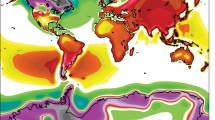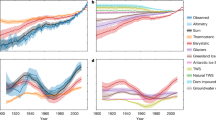Abstract
Reconstructions of monthly mean sea-level grid-point pressure from station pressure data over the Arctic region using an objective technique have revealed two serious errors in the gridded data. First, all gridded data (from the U.S. Historical Weather Map series) for the Arctic Ocean area away from the North Atlantic sector appears to be between 4 and 6 mb too high before about 1931. The semi-permanent Arctic high produced in the early historical map series was the result of a lack of basic station data, and the belief amongst many North American meteorologists of the 1920s and 1930s of the existence of a polar or glacial anticyclone. The second error affects only north-western North America for the years 1899–1909. Here pressure is again too high compared with reconstructed data. The cause of this error is not immediately apparent, but is probably the result of an erroneous correction to sea level for stations in the region. Both errors seriously affect the homogeneity of the gridded Arctic series. The objective scheme used to reveal the errors, can also be used to derive correction factors for the gridded data prior to 1931.
Similar content being viewed by others
References
Baur F (1929) Das Klima der bisher erforschten Teile der Arktis. Arktis 2: 77
Berry FA, Owens GV, Wilson HP (1953) Arctic track charts. In: Proceedings of the Toronto Meteorological Conference, Symposium on Arctic Meteorology, pp 91–102
Birkelund BJ (1934) Old meteorological observations at Vardø, Geofys, Oslo X, No 4, pp 27
Birkelund BJ (1949) Old meteorological observations at Trondheim. Geofys, Oslo XV, No 4, pp 27
Bradley RS, England J (1979) Synoptic climatology of the Canadian High Arctic. Geogr Ann 61A: 187–201
Bradley RS, Kelly PM, Jones PD, Diaz HF, Goodess C (1985) A climatic data bank for the Northern Hemisphere land areas, 1851–1980. DoE Technical Report No. TR017, US Dept of Energy, Carbon Dioxide Research Division, Washington DC, pp 335
Briffa KR, Jones PD, Wigley TML, Pilcher JR, Baillie MGL (1986) Climate reconstructions from tree rings: Part 2, Spatial reconstructions of summer mean sea-level pressure patterns over Great Britain. J Climatol 6: 1–15
Dorsey HG (1945) Some meteorological aspects of the Greenland ice cap. J Meteorol 2: 135–142
Dorsey HG (1951) Arctic Meteorology. In: Compendium of Meteorology. Am Meteorol Soc, Boston, pp 942–951
Dzerdzeevskii BL (1945) Tsirkuliatsionnye skhemy v troposfere Tsentral noi Artktiki. Izdatel' stro Akademii Nauk. English translation in Scientific Report No. 3 under Contract AF 19 (122)-228 UCLA
Hobbs WH (1926) The glacial anticyclones, the poles of the atmospheric circulation. Macmillan, New York, pp 198
Hobbs WH (1945) The Greenland glacial anticyclone. J Meteorol 2: 143–153
Hobbs WH (1948) The climate of the Arctic as viewed by the explorer and meteorologist. Science 108: 193–201
Jenne R (1975) Data sets for meteorological research. NCAR Technical Report 1A-111, National Center for Atmospheric Research, Boulder, Colorado
Jones PD, Wigley TML, Briffa KR (1983) Reconstructing surface pressure patterns using principal components regression on temperature and precipitation data. Proc Int Meeting on Statistical Climatology, Instituto Nacional de Meteorologiae Geofisica, Lisbon, 4.2.1–4.2.8.
Jones PD, Raper SCB, Bradley RS, Diaz HF, Kelly PM, Wigley TML (1986a) Northern Hemisphere surface air temperature variations, 1851–1984. J Climate Appl Meteorol 25: 161–179
Jones PD, Wigley TML, Briffa KR (1986b) Monthly mean pressure reconstructions for Europe (to 1780) and North America (back to 1858). DoE Technical Report No. TR0, US Dept of Energy, Carbon Dioxide Research Division, Washington DC
Karl T, Williams CN, Young PJ, Wendland WM (1986) A model to estimate the time of observation bias associated with monthly mean maximum, minimum and mean temperatures for the US. J Climate Appl Meteorol 25: 145–160
Klein WH (1957) Principal tracks and frequencies of cyclones and anticyclones in the Northern Hemisphere. Research Paper No. 40, US Weather Bureau, Washington DC
van Loon H, Rogers JC (1978) The seesaw in winter temperatures between Greenland and northern Europe. Part I: General Description. Mon Weather Rev 106: 296–310
van Loon H, Madden RA (1983) Interannual variations of mean monthly sea-level pressure in January. J Climate Appl Meteorol 22: 687–692
Madden RA (1976) Estimates of the variability of time-averaged sea-level pressure. Mon Weather Rev 104: 942–952
Namias J (1958) The general circulation of the lower troposphere over Arctic regions and its relation to the circulation elsewhere. In: Polar Atmosphere Symposium, Part 1, Meteorology Section. Pergamon, London, pp 45–61
Parker DE (1984) Collation and improvement of early meteorological data for Sitka. Alaska. US Meteorological Office, Branch Memorandum, No. 139
Paulsen A (1883) Exploration Internationale des Regions Arctique 1882–83 Expedition Danoise, Observations Faites à Godthaab. Danish Meteorological Institute, Copenhagen
Rae RW (1951) Climate of the Canadian Archipelago, Department of Transport, Toronto
Preisendorfer RW, Zwiers FW, Barnett TP (1981) Foundations of principal component selection rules. SIO Ref. series 81-4, Scripps Institution of Oceanography, La Jolla, California
Reed RJ (1959) Arctic Circulation Studies. Department of Meteorology and Climatology, University of Washington. Final Report AF Contract 19(604)-3063. AFCRC: TR-59-284, pp 57
Reseau Mondial (1910–1934) Ann Vols, Meteorological Office, London
Rodewald M (1950) Zur Frage der Luftdruckverhältnisse in der Arktis. Ann Meteorol 3: 284–290
de Tillo A (1890) Repartition geographique de la pression atmospherique sur le Territoire de L'Empire de Russie, 1836–85. La Societe Imperiale Russie de Geographie, St. Petersburg
Trenberth KA, Paolino DA (1980) The Northern Hemisphere sea-level pressure data set: trends, errors and discontinuities. Mon Weather Rev 108: 855–872
Williams J, van Loon HH (1976) An examination of the Northern Hemisphere sea-level pressure data set. Mon Weather Rev 104: 1354–1361
Author information
Authors and Affiliations
Rights and permissions
About this article
Cite this article
Jones, P. The early twentieth century Arctic high — fact or fiction?. Climate Dynamics 1, 63–75 (1987). https://doi.org/10.1007/BF01054476
Received:
Accepted:
Issue Date:
DOI: https://doi.org/10.1007/BF01054476




